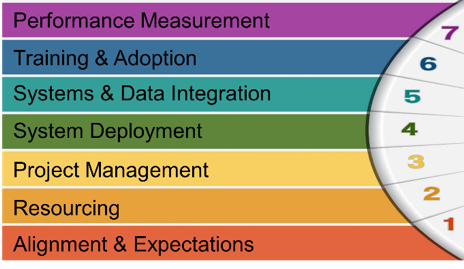
Read Part 1: Choosing the Right MarTech Tools for Your Demand Factory™
It’s complicated and sometimes confusing, for sure – but building a Demand Factory™ doesn’t have to feel like a Laurel and Hardy routine! In my recent marketing technology post I talked about how putting strategy first helps you avoid the temptation of checking out every exciting new technology that comes along. Virtually all marketing initiatives fall under “ACME”: the need to Acquire leads, Convert them to customers, Measure marketing’s performance, and Expand customer value. Once you’ve laid out your marketing strategy and figured out where your gaps are, then it’s time to set priorities for the technology you want to put into place to address your deficiencies.
Like a set of “essential food groups,” I find that organizing technologies in terms of essential categories is very helpful as you begin to look at what you need. Although there are thousands of marketing tools (and the number seems to grow every week), they fall largely into these seven categories:
- Content Creation Tools
- Content Management Tools
- Marketing Automation Systems
- Account-Based Marketing Systems
- Lead Management Tools
- Data Management Tools
- Reporting Tools
To build a complete Demand Factory, you’ll be considering technologies in each one of these categories. We are starting to see overlap among the categories: for example, Marketo has bolted on Account-Based Marketing capabilities inside its marketing automation system (although for an added cost), while Engagio offers a stand-alone account-based marketing system that integrates with the leading marketing automation systems. Lead management capabilities for scoring and nurturing are also embedded in the leading marketing automation systems, but there are complementary solutions like predictive scoring tools that you might need to bolt on to enhance your lead scoring approach. It all really depends on your level of sophistication, needs, and resources. You don’t have to have an independent solution for each category, but at a minimum you need to have robust capabilities in those seven areas to play in the modern marketing arena.
For example, you’ll need not only products such as Adobe Creative Cloud that allow you to build documents (the Content Creation category), but also tools like Vidyard and Uberflip that allow you to deploy and optimize different kinds of content (Content Creation somewhat overlapping into Content Management) as well as straight Content Management tools like Kapost and others that are essential for content marketing.
In this blog post, I want to offer you some suggestions for bringing new technologies into play most efficiently and effectively.
The graphic below illustrates our approach when we help clients prioritize technology initiatives and implementations.

- Alignment and expectations. Do the key stakeholders agree on the need for this tool? It’s critical to have cross-departmental alignment on major technology initiatives. For example, when considering a sales enablement tool, you’ll want to have Sales involved early in the process – because a tool selected without their buy-in won’t be well received or easily adopted. No one likes to have a new tool or process dumped on them. You’ll end up with little to no adoption, and you’ll waste time and money. Identify alignments that are required for each technology category, and collaborate to set expectations with the teams up front. Trust me, as one who has been there: you’ll be glad you did.
- Resourcing, or as I like to say, “Who You Gonna Call?” I’ll talk about this in more depth further on, but basically, two sets of resources are needed for every technology adoption: the people to put it in place, and the people to operate it going forward. Sometimes they can be internal resources, but more commonly marketing teams work with outside agencies like DemandGen or other firms that have the expertise, bandwidth, and experience both for rapidly deploying systems and for providing ongoing “Marketing as a Service” after systems are up and running.
- Project management. Do you need a project manager and project management plan for deployment? For any but the smallest projects, you definitely do. When it comes to a project manager, it’s very hard to leverage an internal team member who lacks the experience and rarely has the bandwidth. Some vendors may be able to provide you with a project manager for deployments. Another alternative is again to leverage marketing technology agencies like DemandGen who have certified project managers and proven project plans to ensure your implementation goes quickly and smoothly.
- System deployment. Once a project manager is identified and engaged, you can plan your deployment. Success here has a lot to do with setting expectations across the team members who will be impacted and involved. Schedule a kickoff meeting led by the project manager and key stakeholders. The agenda should start with the “Why”: re-frame the reasons for deploying the system as an initiative that involves everyone. Then cover the “What,” starting with the end in mind: share what success will look like. Then quickly get to the meat of “What” will be done, by when, and by whom. After kickoff, your project manager should be the one to coordinate the resources, manage scheduling, and track deliverables.
- Systems and data integration. Whatever you are deploying will most likely be integrated with other systems, so it’s essential you have resources with the know-how to accomplish the key integrations. For example, if you use webinars in your marketing mix, you’ll want data from the webinar platform to flow back into your marketing automation (MA) system to track registrations and attendance. In ecommerce, you’ll want your free trial registrations to also flow into the MA system to enable you to adjust your nurture streams as people convert from trial to purchase. Integrations should be designed so that you can make changes to them down the road – to accommodate things you haven’t even thought of yet – so consider how this tool will handle those future situations and engage experts (often outside your organization) to document and perform the integrations.
- Training and adoption. Every new technology has a learning curve, and some curves are steeper than others. How similar or different is this tool from what the team is using now? How much training is needed up-front and long-term? Will the team adopt it easily, or do they need an outside trainer to reinforce its value and boost their skill set?
- Performance measurement. What does success look like with this tool? Most marketing tools are subscription-based, which means a year or two from now you will need to renew your subscription. Leading up to that, you’ll need to justify continued use and investment in this tool, in terms of both the licensing fees and the cost of using it. If you determine up front what success looks like, you can measure ROI against that vision. Ask your vendor, references, and your agency partner what you can expect in terms of impact to your marketing efforts within three, six, and twelve months of proper adoption. Then track your progress against those expectations. Here’s a secret for you: the majority of failed outcomes from marketing tech investments stem from buying a tool that wasn’t needed in the first place, or (more often) from the lack of a plan and committed resources to fully embrace it to a point of success.
Resourcing Considerations: Internal vs. Vendor vs. Agency
A few more thoughts on resourcing, both for deployment projects and ongoing marketing operations:
Using Internal Resources. Do you have in-house expertise? If not, how will your team get the expertise they need through training? What’s the time commitment needed for deployment and ongoing adoption? Will they need to give something else up to fit this new initiative in? Perhaps most importantly, do these people embrace change easily and buy in to the expectations you’ve set? If you need to hire, look for people who do embrace change, love learning new things, are risk takers, and are not technology laggards. If you have a lot of people who resist change in your organization. . .maybe you need to upgrade your team. If everyone is “too busy” to take something else on, consider what they can give up that won’t impact the business. You could hire new team members, but the lowest cost, faster, higher impact approach is often to leverage outside expertise to get you up and running and on the road to success. Working alongside outside experts will more likely ensure the team’s success — and your own, as the key stakeholder.
Using the System/Tool Vendor. In your evaluation of their technology, find out what type of training is available, and if the vendor has online resources versus just know-how trapped in their team’s heads. What’s included in the license fee? How big, and how available, is their professional services team? Do they have certified partners they can recommend? Find out how much knowledge and experience they have in integrating their product with your other systems. Check references to find out customers’ experiences working with the professional services team. Bottom line: if all you need to know from them is how their product works and gets configured, you can consider their professional services team. But if their product has to integrate with and leverage other parts of your MarTech stack and data set, consider an agency who has the breadth and depth of experience that you truly need.
Using an Agency. If you can’t tell already: I think a marketing technology agency like DemandGen will far and away deliver the best experience and results in your marketing technology projects. That’s why I founded one ten years ago: because I didn’t have one to use! Unlike using internal resources, an agency can bring vast experience and dedicated focus to your project to deliver rapid value. Unlike a system/tool vendor, a good agency will be proactive rather than reactive, and prescriptive rather than rigid. For example, an agency like DemandGen will offer experience in MarTech stack integration rather than just MA experience, and will focus on customizing for your needs rather than making you change your needs to fit a vendor’s so-called best practices (AKA “this is the only way we know how to do this”). And an agency like DemandGen can offer the option of managed services as well as project-based services to support your ongoing needs, alleviating the need to hire more and more full-time resources that can sometimes lead to bloat and layoffs when the business scales back. You are in far more control of your budget and outcomes using an agency like DemandGen for marketing technology initiatives.
In my next post, we’ll explore the thrill of the chase: choosing the right vendors.
 For more than 20 years, David Lewis has been a pioneering innovator in digital marketing, and has overseen marketing for some of Silicon Valley’s leading technology firms. He founded DemandGen in 2007 to build the worlds’ first marketing technology agency.
For more than 20 years, David Lewis has been a pioneering innovator in digital marketing, and has overseen marketing for some of Silicon Valley’s leading technology firms. He founded DemandGen in 2007 to build the worlds’ first marketing technology agency.
For the past decade, David and his team at DemandGen have been at the forefront of the transformation taking place in marketing by helping hundreds of the top sales and marketing teams around the world incorporate sales and marketing technology to drive growth. David is an accomplished industry speaker, thought leader, author, and host of DemandGen Radio, a bi-weekly podcast devoted to educating marketing professionals on the best technologies and methods for driving growth. His ground-breaking work on the transformation of marketing and sales is at the heart of his #1 book on Lead Management, Manufacturing Demand: The Principles of Successful Lead Management.
The post Who’s on First, What’s on Second? – Setting Technology Priorities appeared first on DemandGen.
About the Author
More Content by DemandGen


















